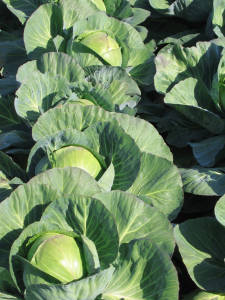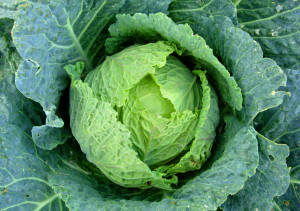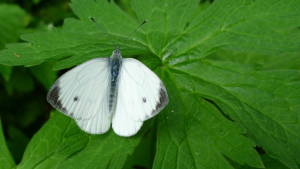Cabbage is a nutrient rich vegetable that is especially healthy when eaten raw. Cabbages grown in the backyard will allow this to be done with no facial grimacing at all! There are many different varieties of cabbage that can be grown the year around, but cool weather produces the best results. The art is choosing the right sort for your climate. Ask around your local shops to find the one that suits you. It’s possible to sow a few varieties with different maturation times for a continuous supply.
Planting Cabbage
Sow seeds in seedbeds, trays or punnets. Transplant when they are 10cm high or have 5 leaves (the same rules as for cauliflower). Make sure the soil is moist for the transplantation process and plant them deeply. Alternatively, you can sow seeds directly in to the ground at a depth of half an inch (1.5cm). As they grow they will require thinning.
As usual, prepare the plot with organic matter and complete fertilizer a few weeks before planting, and loosely rake the soil immediately before planting.
Eventually, cabbages should appear to be in a grid with 2 feet (60cm) between rows and plants. Smaller varieties will do well with a little less space in between individual plants – around 18 inches (45cm).
Growing Cabbage
Temperatures around 15°-20°C are best for growing cabbage. It prefers the cool over the heat, so err on the bottom side of the temperature range. pH 5.5 – 7.0 is required. The type of soil really depends on the type of cabbage – later varieties do best in moisture-rich soil, whereas earlier varieties do fine in sandier soil.
The trick to growing cabbage is consistency of moisture. They do worst if there is a period of heavy rain followed by a dry spell. The gardener can combat this by providing water twice a week, an inch at a time, and holding back during heavy moisture. Feeding cabbage a fish-based fertilizer or seaweed extract every fortnight will produce the best results.
Earth up around the stems to aid stability if the weather is particularly windy.
Harvesting Cabbage
Maturation times vary per variety. 8 weeks is the minimum time, and 16 weeks the maximum.
Cabbage does not store fantastically well frozen. You should choose the best of the heads to freeze, after shredding and then blanching for 1 minute. Cabbage will store fresh for about a week in the refrigerator or shed. Again, how long it keeps depends on the variety.
Threats to Cabbage
Bugs are the biggest threat to cabbage. Keep an eye out for aphids, moths, maggots and worms.
A couple of different fungal diseases result in discoloration of the leaves. Simply remove the leaves as soon as possible. Clubroot is reasonably common with cabbage – ensure the soil is limed to a pH of above 6 if this happens.



